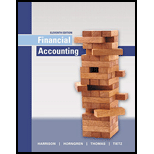
1.
To Compute: The classified
2.a
The carrying amount of the bonds payable by combining the long-term and current amounts.
2.b
To Identify: The reason for which interest payable is reported less than interest expense.
3.
To Identify: The number of times Incorporation B cover its interest expense during 2016.
4.
To Calculate: The leverage ratio and Debt ratio of the company and also evaluate the health of the company from a leverage point of view.
5.
To Find: The change in leverage ratio and debt ratio if the company had to capitalize their lease in 2016 and also to evaluate the company’s health from the leverage point of view.
Want to see the full answer?
Check out a sample textbook solution
Chapter 9 Solutions
Financial Accounting Plus MyLab Accounting with Pearson eText - Access Card Package (11th Edition)
- I need help with this General accounting question using the proper accounting approach.arrow_forwardAn analyst has projected that Gina Corp will have assets of $12,500 at year-end and liabilities of $8,900. The analyst's projection of total owners' equity should be closest to: A. $3,600 B. $4,200 C. $2,900arrow_forwardDeluxe Industries used direct materials totaling $78,350; direct labor incurred totaled $217,600; manufacturing overhead totaled $389,200; Work in Process Inventory on January 1, 2022, was $195,400; and Work in Process Inventory on December 31, 2022, was $204,300. What is the cost of goods manufactured for the year ended December 31, 2022? please provide answerarrow_forward
- I am looking for help with this general accounting question using proper accounting standards.arrow_forwardCould you help me solve this financial accounting question using appropriate calculation techniques?arrow_forwardHemsworth Electronics company has a beginning finished goods inventory of $24,500, raw material purchases of $35,600, cost of goods manufactured of $42,800, and an ending finished goods inventory of $27,300. The cost of goods sold for this company is?need helparrow_forward
- Please provide the answer to this financial accounting question with proper steps.arrow_forwardThompson, Inc. had accounts receivable of $580,000 and an allowance for doubtful accounts of $23,400 just before writing off as worthless an account receivable from Sullivan Company of $2,750. The net realizable value of the accounts receivable before and after the write-off was: A. $556,600 before and $556,600 after. B. $603,400 before and $600,650 after. C. $556,600 before and $553,850 after. D. $580,000 before and $577,250 after.arrow_forwardI am looking for help with this general accounting question using proper accounting standards.arrow_forward

 AccountingAccountingISBN:9781337272094Author:WARREN, Carl S., Reeve, James M., Duchac, Jonathan E.Publisher:Cengage Learning,
AccountingAccountingISBN:9781337272094Author:WARREN, Carl S., Reeve, James M., Duchac, Jonathan E.Publisher:Cengage Learning, Accounting Information SystemsAccountingISBN:9781337619202Author:Hall, James A.Publisher:Cengage Learning,
Accounting Information SystemsAccountingISBN:9781337619202Author:Hall, James A.Publisher:Cengage Learning, Horngren's Cost Accounting: A Managerial Emphasis...AccountingISBN:9780134475585Author:Srikant M. Datar, Madhav V. RajanPublisher:PEARSON
Horngren's Cost Accounting: A Managerial Emphasis...AccountingISBN:9780134475585Author:Srikant M. Datar, Madhav V. RajanPublisher:PEARSON Intermediate AccountingAccountingISBN:9781259722660Author:J. David Spiceland, Mark W. Nelson, Wayne M ThomasPublisher:McGraw-Hill Education
Intermediate AccountingAccountingISBN:9781259722660Author:J. David Spiceland, Mark W. Nelson, Wayne M ThomasPublisher:McGraw-Hill Education Financial and Managerial AccountingAccountingISBN:9781259726705Author:John J Wild, Ken W. Shaw, Barbara Chiappetta Fundamental Accounting PrinciplesPublisher:McGraw-Hill Education
Financial and Managerial AccountingAccountingISBN:9781259726705Author:John J Wild, Ken W. Shaw, Barbara Chiappetta Fundamental Accounting PrinciplesPublisher:McGraw-Hill Education





